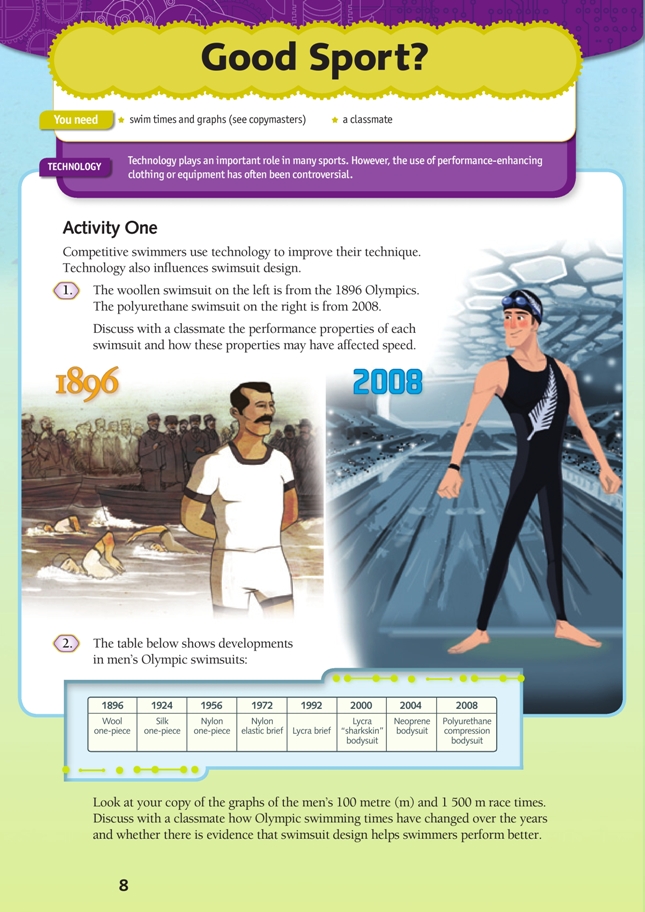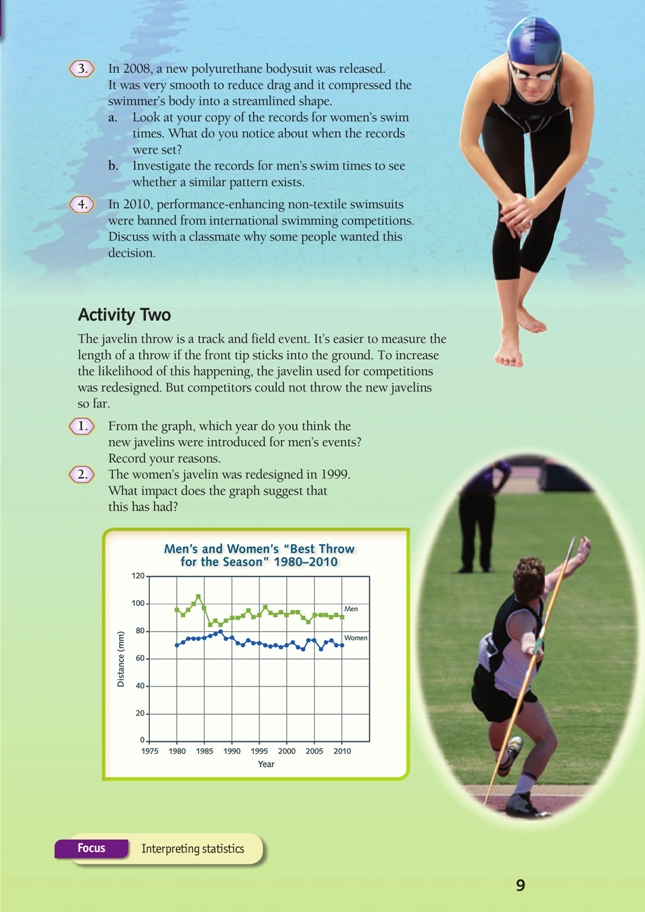This is a level 3 activity from the Figure It Out series.
A PDF of the student activity is included.
Click on the image to enlarge it. Click again to close. Download PDF (621 KB)
Statistical thinking involves the exploration and use of patterns and relationships in data. There are four key processes:
- describing data – connecting the information in a table or graph with a real-life context
- organising and reducing data – ordering, grouping, and summarising
- representing data – creating visual representations
- analysing and interpreting data – recognising patterns and trends and using them to make inferences and predictions.
In these activities, students explore statistics related to international sporting records.
a classmate
swim times and graphs (see copymasters)
When analysing statistical information, it is important not to assume a causal relationship. A causal relationship is one where change in one variable is directly responsible for change in another variable. In many cases, a relationship between two variables does exist, for example, swim times have improved over time and so have swimsuits. However, swimsuit development is not the only factor: developments in nutrition, training, and technique have all played a role. Improvements in pool design have also influenced swim times, for example, increased pool depth to reduce waves and currents, wider lanes, and energy-absorbing lane lines and gutters. It is possible that these changes have had a much greater impact than swimsuit design.
In some instances, a causal relationship seems more likely. For example, the number of swimming records broken since the introduction of the polyurethane full bodysuit suggests that the swimsuit had a significant impact on swim times. Only two of the records on the copymaster were set after the swimsuits were banned.
Interpreting visual representations, such as graphs develops the key competency using language, symbols, and texts.
Background information
The first modern-day Olympics were held in Athens, Greece, in 1896. The swimming competition was held in the open sea because the organisers refused to pay for a specially constructed stadium. Nearly 20 000 spectators lined the shore to watch the races. There were three open events, all for men only: 100 m freestyle, 500 m freestyle, and 1 200 m freestyle. A fourth event was only open to Greek sailors.
In 1900, the swimming events took place in the muddied waters of the river Seine. Two unusual events were held: a 200 m obstacle course that involved climbing over and swimming under rows of boats and an underwater endurance swimming event. Women took part in the Olympics for the first time but were considered too “delicate” to participate in swimming events. Women were first included in swimming events in 1912 (Stockholm Olympics).
The first Olympic swimming pool was built for the 1908 London Olympics. The pool sat in the middle of the main stadium’s track and field oval.
Electrical timing was used for the fi rst time in 1912, the standard 50 m pool with marked lanes was introduced in 1924, and diving blocks in 1936. The flip-turn was introduced by the 1950s and swimming goggles were first allowed in 1976.
Olympic swimmers wore full-body swimsuits until the 1940s. These caused considerable drag in the water.
In 2008, Speedo-sponsored swimmers broke an incredible number of world records. Rival swimsuit companies and the national delegations they sponsored complained that the competition had become unfair. Three-time Olympic champion Pieter van den Hoogenband is reported to have said “This [suit] allows far less talented swimmers to go fast”, making the records meaningless.
Swimmers wearing the polyurethane bodysuit or other non-textile bodysuits set all of the swimming world records, with the exception of some 1 500 m races.
The Speedo LZR Racer swimsuit used ultrasonically bonded seams instead of traditional stitches. It had lowdrag panels embedded within the fabric and was designed with help from NASA. There were complaints that the swimsuit unfairly increased levels of buoyancy. Some of the world-record-breaking swimmers wore two swimsuits during their races.
In 2009, the International Swimming Federation voted to ban non-textile (non-woven) swimsuits from 1 January 2010 to address the problem of measuring the performance of swimsuits, not the swimmers. The new ruling states that the maximum coverage allowed for a man’s swimsuit is from his navel to his knee and the maximum coverage allowed for a woman’s swimsuit is from her shoulder to her knee.
Technology-related student activities
- Discuss ethical issues related to sports technology, for example, the use of performance-enhancing drugs or the inequality between richer and poorer countries in terms of athletes having access to, or funds for, technology.
- Research a particular sport and the role technology has played in its development.
- Debate whether athletes with disabilities should be allowed to use technology to compete against able-bodied athletes.
- Research ways that technology is used to analyse athletes’ performances.
- Discuss possible consequences of placing no restrictions on the design or materials used for a piece of sports equipment, such as a tennis racquet.
- Investigate the characteristics of textiles. What is the difference between a textile and a non-textile swimsuit?
Exploring the technology-related context
Sports technologists aim to improve athlete performance through improved equipment, training methods, and nutrition. Even the slightest of margins can mean the difference between victory and defeat.
Some technological innovations cause controversy. In many sports, limits are placed on technological intervention. In an endeavour based on pushing the limits of human performance, deciding where to draw the line is not always straightforward.
Answers
Activity One
1. Discussion will vary. Possible comments include: the woollen swimsuit would absorb water, making a swimmer heavier and slower; the polyurethane swimsuit makes the body smooth, lessening resistance in the water and enabling the swimmer to move faster.
2. Discussion will vary. Olympic swimming times have continued to improve over time. Improved swimsuits have certainly played a role (see questions 3 and 4), but other factors have also been very important, for example, better nutrition, training, technique, and pool design.
3. a. The world records for almost all events were set after the new swimsuit was introduced.
b. The pattern is the same.
4. Discussion will vary. Possible ideas include:
- The swimsuits gave an unfair advantage to the swimmers who wore them.
- The swimsuits improved performances so much that records could be broken by swimmers perhaps less talented than those who set them.
Activity Two
1. 1986. In 1986 and the years immediately following, distances were less than in the preceding 6 years. The record set with the old-style javelin in 1984 has not been broken since.
2. There appears to have been little impact on the women’s throws, although there has been greater variation in distance since the new javelins were introduced.

